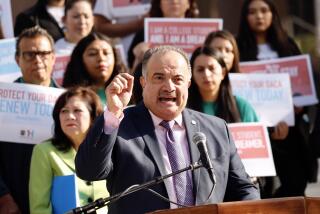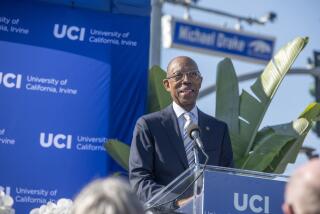New President Vows to Revive Pierce College
- Share via
WOODLAND HILLS — Since its birth in 1947, Pierce College has enjoyed a reputation as a special institution. For years, the campus drew larger enrollments, sent more students on to universities and had wealthier neighbors than any of its sister campuses.
Today, the community college still stands out, but now it’s mostly for the problems it faces:
* Capping a two-year free-fall, campus enrollment this spring plummeted to its lowest level since 1969, dropping it to fourth in student population among the nine colleges in the vast Los Angeles Community College District.
* A collapsed real estate deal has left Pierce facing an estimated $1.5-million budget deficit for the year, the largest in the district. Absent some relief, Pierce will face the further drain of having to repay the debt to the district over three years starting in mid-1995.
* Lingering problems with a lack of institutional direction, poor morale on faculty and staff, and dilapidated facilities--made worse from more than $2 million in damage in the Northridge earthquake--continue to plague the campus.
Into this caldron Monday steps Mary Lee as Pierce’s interim president for at least a two-year stint. After 13 years as president of Valley College in Van Nuys, she arrives at Pierce with a self-described mission to “stop the downward trend and start bringing it up.”
Lee, a 55-year-old Chatsworth resident who was an administrator and part-time student at Pierce in the late 1970s, will become the institution’s sixth president since then. Lowell Erickson, Pierce’s president since mid-1991 who sought a leave, said he will move to the district’s Downtown Los Angeles headquarters.
Even before her official start, Lee last week was already talking changes. Some proposals include transferring underused occupational programs at Pierce to other campuses by this fall as part of a curriculum shake-up, and new efforts to regain lost enrollment and revitalize Pierce’s trademark farm.
On the Woodland Hills campus, faculty and staff members voiced hope that Lee can bring some direction to a school that many say has been adrift for years. But that hope was tempered with skepticism that she can overcome tight funding for education in general and the district’s own bureaucracy.
Lee said she’s ready for the challenge. “I believe the people at Pierce College are looking for direction,” she said. “And I believe they are looking for someone who can make the tough decisions that they know need to be made--but don’t want to make--in order for the institution to survive.”
Although the district as a whole has been hobbled by declining enrollments, aging facilities and other conflicts, Pierce’s problems appear more severe than those at either of its San Fernando Valley sister campuses. Valley College is considered the district’s most efficiently run campus. Mission College in Sylmar is the newest and fastest-growing site.
In an interview, Neil Yoneji, the chancellor of the 882-square-mile district who is serving on an interim basis, declined to say whether he considered Pierce to be in the worst shape of his nine campuses. But he said the problem there is “a large one.”
The urgency of putting Pierce right was one of the main reasons Yoneji said he decided to move Lee to Pierce last month instead of allowing the campus to have its own search committee, as is the custom.
“My main concern was to stabilize the institution as soon as possible,” he said.
Even with its problems, Pierce College remains a big part of the district. The college still has the largest operating budget, about $21.8 million; its campus, at more than 400 acres, is nearly four times the size the next largest, and it has the highest number of permanent faculty, about 209.
Among other characteristics, the campus’s West Valley service area has higher family incomes than any other district college. Its student body, about 60% white, has the fewest minorities. And the campus has long sent the most students on to four-year institutions, about 1,000 each year.
So where, officials are asking, have all Pierce’s students gone? From fall 1983 to fall 1993, the enrollment decline of 26.2% was by far the largest in the district. The student population during that time dropped from 21,260 to 15,695, its lowest level since 1969.
After dipping below 20,000 in 1984, Pierce’s year-to-year enrollments actually remained around 18,000 for the remainder of the decade. The college had the district’s largest enrollment from 1976 to 1988, dipped below Valley in 1989, and then regained the lead in 1990.
But then the bottom began falling out. A modest 3.2% decline to 18,584 students in fall 1992 was followed by a huge 15.5% decline to 15,695 students by fall 1993, the college’s largest loss on record. Campus officials blamed a that year’s statewide fee hike for students already holding bachelor’s degrees.
Then the earthquake hit this January and the campus lost another 6.6% of its students, to begin this spring semester with only 14,663. The net two-year enrollment loss is nearly 4,000 students, or 21%, leaving Pierce behind Valley, Los Angeles City and East Los Angeles colleges in enrollment.
Lee believes the college has not worked as hard at recruiting students and updating its class offerings as have other campuses. Others said the campus, like others in the large district, is losing students to other nearby community colleges.
Lee is promising a bolstered recruiting campaign this fall. She also is promising a new course work package for certain majors that would guarantee students can complete their transfer requirements in two years.
Maintaining enrollments at California community colleges today is more a matter of survival than pride. State funding for colleges is pegged to their enrollment. So fewer students this year tends to mean less money next year, which then results in even fewer courses and students.
It was the hope of avoiding that downward spiral that led Pierce officials into their current deficit. Faced with a $21.8-million budget this year, 11% below spending in the previous year, Pierce officials limited their course reductions this fall and took a $1-million gamble, which they lost.
Under a deal approved by the district’s Board of Trustees last August, Pierce was to get about $1 million from the developers of the controversial Warner Ridge project nearby in exchange for permission to dump 425,000 cubic yards of soil on vacant Pierce property.
Erickson arranged Pierce’s fall course offerings on the promise the college would get the money, only to have the deal collapse when the Warner Ridge project unraveled in January. Now the college is out the $1 million, as well as several hundred thousand dollars in related costs, officials said.
In the aftermath, Lee said the college’s academic offerings must become self-supporting. “Outside funding is not going to rescue curriculum review and the revitalization of the instructional program,” she said.
Lee said she is looking at cost-cutting moves that include canceling or restructuring an as-yet unspecified number of vocational classes at Pierce. The college’s industrial technology department, one of several overstaffed for its enrollment, is considered one likely target.
In the event of cutbacks, instructors of affected classes would be transferred to other district campuses. Since many of Pierce’s faculty members are longtime veterans, however, one district official said the move might also spur retirements.
Lee also has talked of possible cuts in the college’s athletic programs. And district officials are talking about consolidating various support services among the district’s three Valley campuses.
And then there is the question of what will become of Pierce’s farm.
Although it has deteriorated in facilities and activities over the years, the farm and horticulture area account for about 240 of Pierce’s more than 400 acres.
To local residents, the property is a bastion of open space and Valley history. To others, it’s a money-making prospect that lies fallow. Although district officials said there are no plans at present to sell off the property, it has been proposed for various commercial ventures in the past, including a golf course and an equestrian center. Lee, who took agriculture classes at Pierce when she worked there and at Valley between 1977 and 1981, has proposed trying to upgrade the farm with both historic and high-tech elements. By offering tours for schoolchildren and holding community activities there, she said the farm could serve as a campus recruiting attraction.
Mick Sears, chairman of Pierce’s agriculture and natural resources department, said he has been encouraged by Lee’s statements favoring efforts to revitalize the farm. But he’s less optimistic that his courses will survive cost-cutting moves.
Pierce began in 1947 as the Clarence W. Pierce College of Agriculture, named after the board member who spearheaded its founding. The college’s original mission was to train war veterans for agriculture careers, but weak demand even then soon led to a broader curriculum.
Lee is optimistic about the farm’s future despite the tough economic times. She hopes to persuade off-campus groups to pay for improvements. But Sears said district bureaucracy and ambivalence has long stymied upgrades.
If anything, Pierce remains a college with a chip on its shoulder, and some say deservedly so. Faculty members who teach in leaky classrooms, use antiquated equipment or swelter in the summer because much of the campus lacks air conditioning say the district has bled Pierce dry over the years.
“There’s an element of truth to that,” concedes Yoneji. For years, the district’s larger colleges such as Pierce earned money that was shifted to the smaller campuses.
“The district’s been siphoning off resources, and now they’re very angry at Pierce because we’re not the cow that’s producing all that milk anymore,” complained Sid Elman, a political science professor and head of the faculty union chapter.
In recent years, larger colleges such as Valley and Pierce have been getting general operating funds ranging between $2,100 and $2,300 per full-time student. Smaller colleges such as Southwest, West Los Angeles and Harbor have received $2,400 to more than $3,000, records show.
Add to the mix the series of presidents who have cycled through Pierce, most installed by the district rather than picked by the campus. And the result, as chemistry professor Barrie Logan said, has been “an increasing sense of drift and a lack of anyone doing anything to try to reverse this.”
During her tenure, Lee countered, she will not accept a lack of money or district cooperation as excuses for failed initiatives.
And to her new campus, she said: “I believe a college president can make a big difference.”
Community College Enrollment
Fall semester credit enrollments, at Los Angeles Community College District schools, 1983 and 1993.
COLLEGE FALL 1983 FALL 1993 CHANGE % L.A. City 17,568 15,270 -2,298 -13.1% East L.A. 15,779 14,531 -1,248 -7.9% Harbor 9,977 8,040 -1,937 -19.4% Mission 3,855 6,097 +2,242 +58.2% Pierce 21,260 15,695 -5,565 -26.2% Southwest 6,246 5,352 -894 -14.3% Trade Tech 14,848 12,617 -2,231 -15.0% Valley 20,084 16,638 -3,446 -17.2% West L.A. 8,921 7,617 -1,304 -14.6% District Total 118,538 101,857 -15,738 -14.1%
Source: Los Angeles Community College District
More to Read
Sign up for Essential California
The most important California stories and recommendations in your inbox every morning.
You may occasionally receive promotional content from the Los Angeles Times.













